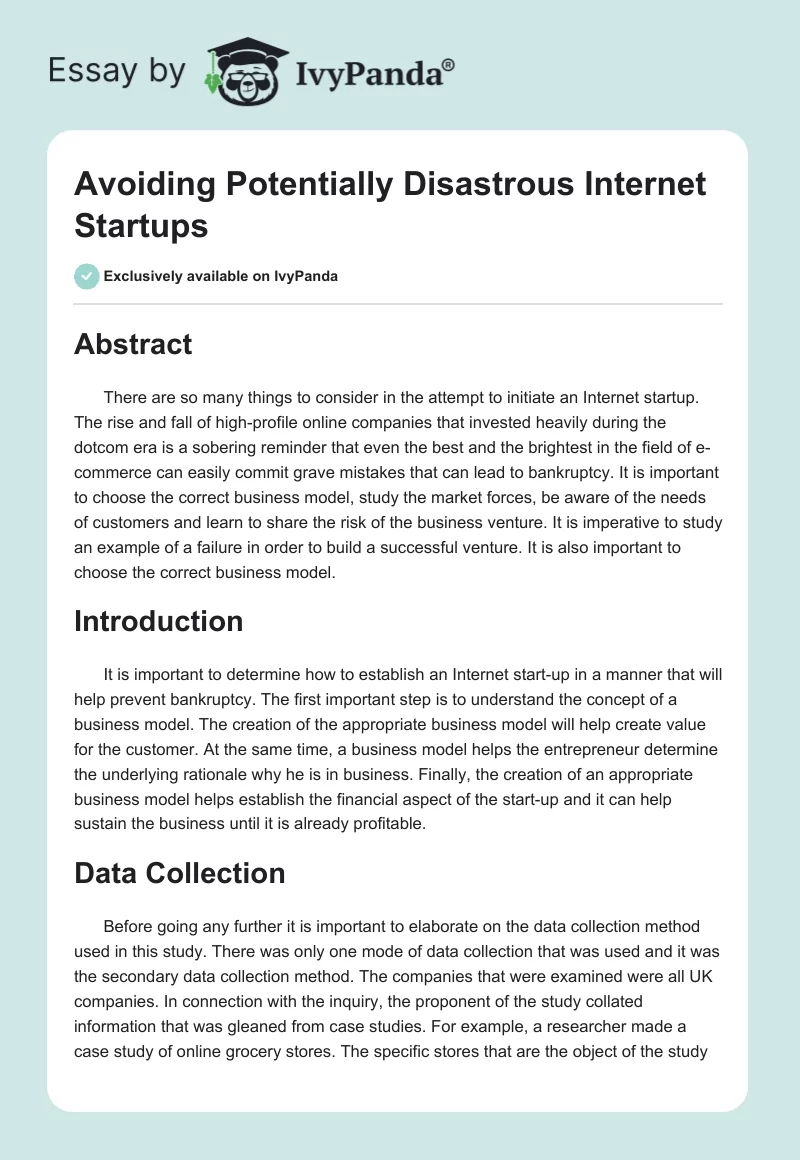Abstract
There are so many things to consider in the attempt to initiate an Internet startup. The rise and fall of high-profile online companies that invested heavily during the dotcom era is a sobering reminder that even the best and the brightest in the field of e-commerce can easily commit grave mistakes that can lead to bankruptcy. It is important to choose the correct business model, study the market forces, be aware of the needs of customers and learn to share the risk of the business venture. It is imperative to study an example of a failure in order to build a successful venture. It is also important to choose the correct business model.
Introduction
It is important to determine how to establish an Internet start-up in a manner that will help prevent bankruptcy. The first important step is to understand the concept of a business model. The creation of the appropriate business model will help create value for the customer. At the same time, a business model helps the entrepreneur determine the underlying rationale why he is in business. Finally, the creation of an appropriate business model helps establish the financial aspect of the start-up and it can help sustain the business until it is already profitable.
Brief Overview of Information Technology
It is impossible to understand the significance and economic impact of a dotcom or Internet start-up without grasping the historical development of the Internet and its overarching umbrella called Information Technology. In the past, computers were considered impractical because oft its size and cost. But when men like Bill Gates, Steve Jobs, and Michael Dell revolutionized the design and capability of personal computers, the average person began to own and use computers in the comfort of their own homes.
Access to personal computers was just the beginning. When researchers, scientists, and inventors combined forces to create the World-Wide-Web and made it possible to connect personal computers from one continent to the next, the Digital Age began (GS1 MobileCom, 2012). The significant level of cost-efficiency achieved by this network of computers prompted the development of new business models that revolutionized business-to-business and business-to-consumer sectors.
The parallel development in computer hardware, computer software and communication links such as cables and fibre optics contributed to the rapid transformation of Information Technology. The improvements in the graphical interface of personal computers, particularly the creation of highly-functional websites ushered in a new way of doing business. It did not take long before entrepreneurial minds thought of a more innovative way to use these technologies. Websites became a tool to deliver advertising content and as portal to communicate with customers.
Business savvy IT specialists who worked with investors were able to create websites that has the potential to reach more customers as compared to conventional mass marketing methods. These new breed of businessmen were able to develop multi-million dollar deals on the basis of an idea alone. These were created from an imaginary model because the business models that the proposed to investors were without precedence. For example, the idea of an online grocery store was non-existent since the beginning of time.
The success of IT-based companies such as Microsoft and Apple fuelled the feeding frenzy and investors were looking for Internet start-ups that could be considered as ground-breaking as Google. If the investors were more candid with their disclosure they will concur that they were unable to fully comprehend the business model presented to them.
The hype that surrounded Internet start-ups in the dotcom era blinded many investors to the potential pitfalls in this new form of doing business. But after weathering the storm, venture capitalists and bright young minds with a revolutionary idea were able to develop business models that that they hope to profitable in the Age of Information.
After the embarrassment of the dotcom bubble of the 1990s, the hype that surrounded Internet start-ups began to dissipate. As a result investors were more cautious and entrepreneurs became wiser when it came to the development of business models that were more practical and therefore more profitable. It was not only were the proponents of Internet start-ups that became more adept in the design and marketing of their proposed Internet start-ups. The general public also learned to appreciate the benefit of using online resources as a way to access information and at the same time as a tool to conduct a business transaction.
Another important issue to consider is the rapid changes in the development of new technology. A start-up company must be agile enough not to be bogged down by the need to pay for expensive equipment only to discover a few months later that the requirements of the business has changed due to significant addition of new users. It is therefore imperative to develop a strategy that allows for a limited cash outlay.
Failed internet start-ups were the result of bankruptcy. These failed attempts were exacerbated by the fact that their respective CEOs spent a great deal of investor’s money on sophisticated software and computer hardware that may not have practical application. On the other hand the company cannot create a system that creates inefficiency. It is easier said than done but the organization has to learn to build a structure and purchase particular equipment only when it is absolutely necessary.
It is also important to invest in computer hardware and software that would ensure adequate deterrence from external and internal attacks. However, there is a danger that business leaders will overdo it. According to Gene Spafford, an IT consultant, “The only system that is truly secure is one that is switched off and unplugged, locked in titanium-lined safe, buried in a concrete bunker, and is surrounded by nerve gas and very highly paid armed guards. Even then, I wouldn’t stake my life on it” (Shelly & Vermaat, 2010, p.593). The exaggerated remark was meant to clarify the need for security but at the same time the need to understand that even the most expensive system is not tamper-proof. There is a need to balance security and cost.
Security and accessibility must be balanced but managers must err on the side of caution. In the Information Security Management Handbook security experts explained the economic and strategic impact of hackers and other forms of unauthorized entry:
Intrusion in information system security simply means the attempts or actions of unauthorized entry into an IT system. This action ranges from a reconnaissance attempt to map any existence of vulnerable services, exploitation/real attack, and finally embedding of backdoors. Such a malicious process can result in the creation of an illegal account with administrator privileges upon the victim’s machine (Shelly & Vermaat, 2010).
A hacked account is more devastating if the intruders are able to steal and use credit card information. Imagine the backlash from the customers if they learn that the site cannot be trusted because unauthorized entry from internal and external sources exposed them to the risk of identity theft and other mischief. An Internet start-up cannot afford a breach in their security protocols.
The importance of security must be balanced by the added cost to the system. It is therefore important to choose the right consultants for the job. It is much better to spend money on reliable consultants rather than purchase expensive equipment and software that will later on prove to be useless for the company. An expert can help the company develop the necessary system in the most cost-effective manner.
It is important to consider the need to build a system from scratch. It is not practical to purchase a system copied from another company. It is impractical to use that particular system because it was created without consulting key employees of the organization. A system developed with the collaboration of the workers is more reliable. In addition, it ensures that there will be minor complaints from the users. In other words, the potential problems of the design were already dealt with prior to final delivery of the product. If this process was not in place, then, the management information system may contain errors that may prove costly and time-consuming to fix.
The Attractiveness of Internet Start-ups
Those who succeeded in the Internet start-up battle of the 1990s found out that the value of their company skyrocketed to levels unheard of in the past. Others experienced more modest levels of success. After some time e-commerce became an acceptable business model in the world. E-commerce or electronic commerce is synonymous to speed and efficiency. In the conventional business model such as a brick-and-mortar store, the customers needed to leave the comfort of home in order to pick up an item that they wanted to purchase. In this new model, the speed of transaction can be as quick as the click of a computer mouse.
Once an order has been made, a delivery mechanism can take care of the movement of goods from the store to the client’s home. In an ideal setting the client need not spend money and waste time because of the need to personally purchase a particular product. At the same time the business establishment can communicate directly to the consumer in the event of non-delivery or the availability of the item requested (Talbot, 2010).
Furthermore, business establishments can deal with multiple customers at a given period of time. In the traditional way, such as in a brick-and-mortar store, customers had to wait in line and business owners were only able to deal with one customer at a time.
When e-commerce became an accepted method in the marketing of goods and services, the use of IT-based applications reached the next level through the introduction of M-commerce. M-commerce means mobile commerce or the use of mobile devices to transact with businesses that used an e-commerce platform (Finnegan, 2010). Examples of such portable devices were mobile phones, laptops, iPads and other computer tablets. The advent of M-commerce promised another significant increase in the value of business organization that utilized an e-commerce platform.
The promised convenience towards business transactions easily created a popular demand for this type of service. Business leaders were also excited with the possibility to enhance their business-to-consumer strategies. For example, entrepreneurs and their sales representative had the capability to send messages and connect with potential and existing clients at a fraction of a cost.
At the same time their clients can receive information instantaneously even if they are not home. The outcome is predictable such as the capability to make decisions at a faster rate. In a successful interaction with clients, businessmen can easily increase their revenue through a faster rate of transaction with customers.
The most radical feature of e-commerce and m-commerce was the ability of customers to transact without the need of a human-to-human interaction. Computer software were sophisticated enough that a client was able buy clothes, tickets, food, and other items without the need to interface with an operator or even a sales representative. One can just imagine the savings it can generate to the company through the reduction of payroll expenses.
Data Collection
Before going any further it is important to elaborate on the data collection method used in this study. There was only one mode of data collection that was used and it was the secondary data collection method. The companies that were examined were all UK companies. In connection with the inquiry, the proponent of the study collated information that was gleaned from case studies. For example, a researcher made a case study of online grocery stores. The specific stores that are the object of the study are listed as follows: 1) Tesco; Sainsbury’s; Asda; and Safeway. The results of that case study were used by the proponent of this paper.
The secondary data collection method was also applied to collate data with regards to Information Technology. At the same time this particular mode of data collection was used to learn more about pertinent details with regards to Internet start-ups. Since it was not a primary data collection mode, it must be pointed out that there were certain weaknesses with regards to this data collection process.
For instance, the proponent of this study was dependent on the integrity of the original report and original case study. There was no way to check the veracity of the data that was used by the author of the case study when they made certain assertions. In other words, in order for this study to be completed there must be absolute trust in the reliability of the primary research done by others.
Although secondary information was used for this exercise, the problem with reliability of the source of data was rectified by using multiple sources of information. For instance, in the study of Tesco, the major assertions made in that case study were compared with information that came from news articles. In the process, the proponent of this study was able to determine a pattern and made the necessary conclusion.
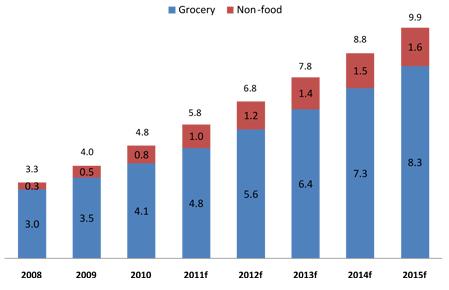
An Example of a Failure
One of the best ways to avoid a disastrous Internet start-up is to analyse a failed attempt. The bulk of this report focuses on emergence of online grocery stores in the United Kingdom. But before going any further it is important to take a look at a failed attempt when it comes to the transition from a traditional brick-and-mortar store to an online business. A good example is the failure of a UK store company called eToys Company UK.
According to one commentary eToy’s collapse served as business lesson for e-business wannabes (Marketing Minefield, 2012). The case of eToys was similar to other companies that ventured into the online business. Most of the time they followed the path that was trail-blazed by other successful entrepreneurs. Many businessmen made the wrong decision that they can copy the work of others.

The problem of eToys can also be linked into the circumstances that surrounded the dotcom era. When eToys was started there were many investors that were in search of the next great idea that can transform thousands of pounds of investment money into millions of pounds of profit. When eToys announced its decision to go online and ventured into the still murky waters of Internet shopping, there were many who believed that this company will be able to rake in millions in profit.
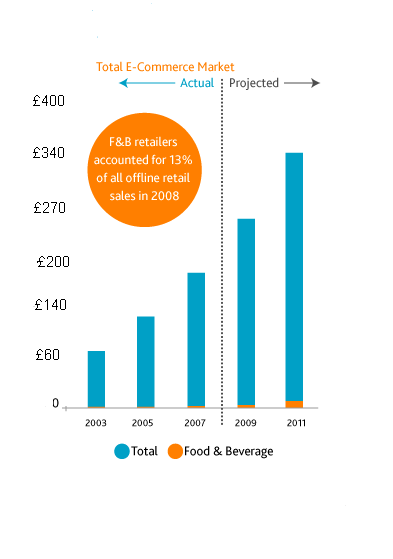
The company was founded in 1997 and because of investor’s money that poured in it grew quickly. The company was able to increase the number of employees from a handful of workers to more than 200 people (Marketing Minefield, 2012). The said company had great potential. If one will consider the hassles involved in shopping, one will be reminded of long lines and the need to travel from home to the store. According to one report the closely watched initial public offering of eToys paved the way for the financial windfall that the company generated in the first two years that it was online (Business Pundit, 2009).
In fact, at the height of its corporate success eToys stock was valued close to £60 in 1999 (Business Pundit, 2009). But two years later the company had to lay off 70% of its workers and in February of 2001 it hinted that it will file for bankruptcy (Business Pundit, 2009).). It was a great story while it lasted.
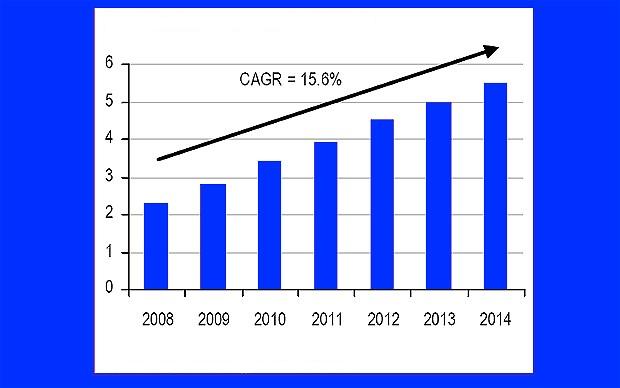
It was an amazing accomplishment if one will consider that the product to be sold were toys. In hindsight, investors both regular and institutional investors should have realized the precarious position of eToys. When the company was established in UK, only a few people knew about it. There were other toymakers and toy stores in the UK that were more prominent. The fundamental failure of eToys was that it tried to grow fast and tried to overwhelm competitors in the shortest time possible.
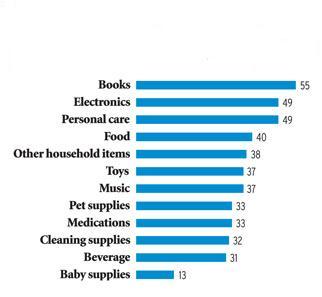
The massive catalogue of toys that they offered combined with competitive prices was supposed to be the formula that they hoped will destroy the competition. They also thought that even though there were many brick-and-mortar stores that sold toys, there was no major threat when it came to online shopping of toys. Their mindset was that since they were the first in the UK online market that sold a particular product, then, they thought that they can build strong and fast. They thought that their competitors cannot build the same platform in the same timeframe.
A major factor that derailed the plans of eToys in the UK was their unpreparedness when it comes to advertising and customer relations marketing (Marketing Minefield, 2012). They were unable to cover a significant portion of the UK toy market. They failed to realize that online stores adhere to the same principles of marketing even if they do not have a physical presence that people can go to in order to purchase the items that they needed.
In other words there was no track record to speak of and there was no marketing campaign that captured the imagination of the public. Other companies had to spend millions of pounds in advertising money in order to persuade people to buy their products. The company underestimated the capability of entrenched competition in the UK market especially when it came to the retail sector.
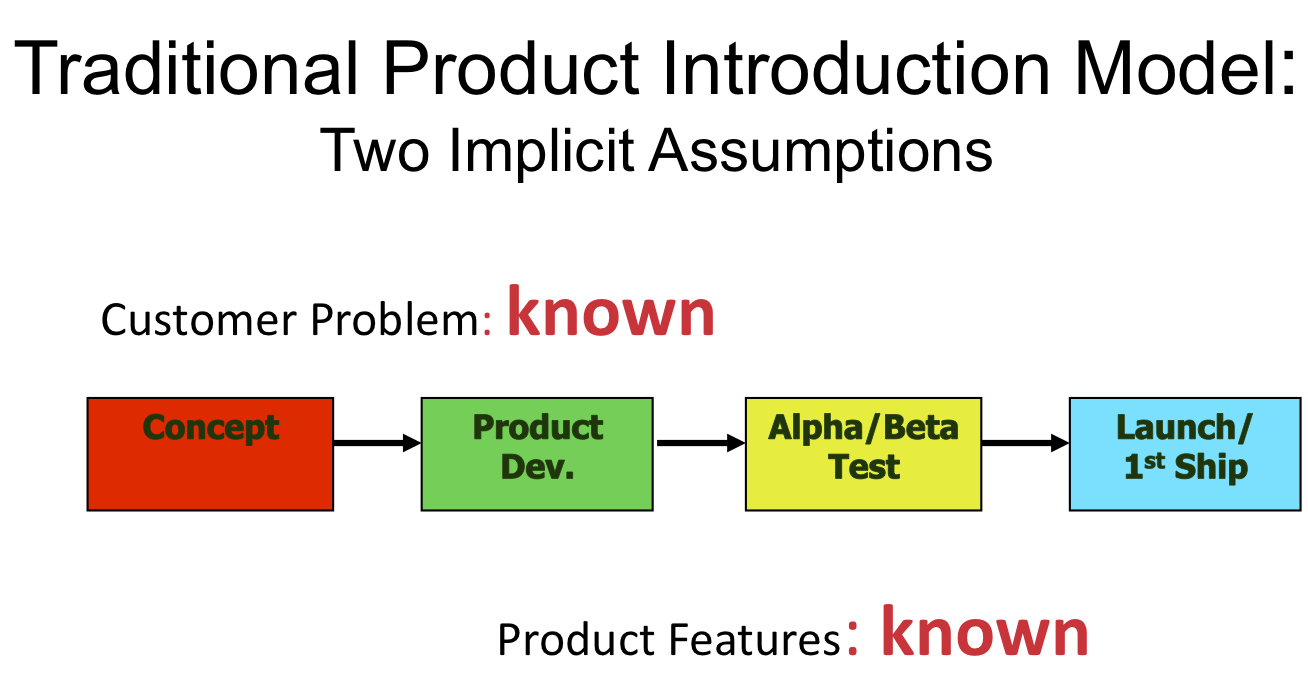
Demand and Supply
There was a common pattern in many of the disastrous Internet start-ups of the 1990s. The common thread that bound these companies together was the absence of a product that people wanted to buy. The simple rule of economics is based on the law of supply and demand. An economy can only occur if there is a need and that there is another entity willing to supply the solution to that need. The auto manufacturing company will not exist if there was no one who needed a vehicle. The same thing can be said about the canned goods industry and other products that were created as a result of demand from customers.
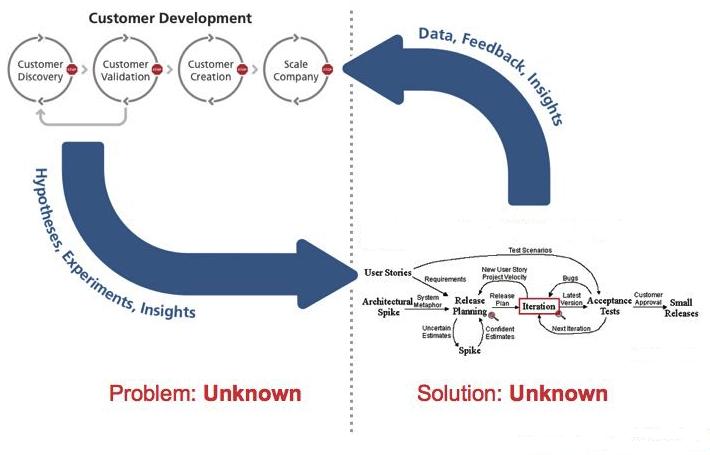
It is therefore important to develop an online business based on a clear business model. It must start with products that have high demand. In this regard there are only a few products that can compete with food and beverage when it comes to high demand from consumers. Thus, one of the best companies that can be transformed into an online business is the grocery store or a supermarket because people cannot live without food and drink.
There is one thing that investors must consider when it comes to online grocery stores. There are examples of online grocery stores that went bankrupt. Thus, even if the seller decided to market goods that were in high demand, there was still a high probability that the business will fail and join the ranks of infamous Internet start-ups. There are many factors that can affect the success of a venture.
According to one analyst an online store must reach critical mass and must have conventional cash flows (Boyes & Melvin, 2011). In other words there must be an optimum number of customers that use the services of the site. At the same time there must be profit that comes from the sales of goods. They must not rely only on bridge financing from investors, they must sell their products. They must be able to generate profit just like other conventional stores.

Business Model
The decision to develop an online store patterned after an ordinary grocery store or supermarket is based on the idea that there was a ready market for these types of products. But as mentioned earlier there are many factors that can easily derail the operation of an online store. Thus, it is imperative to clarify the business model that the entrepreneur must use before building the said online store. According to Jim Williamson of market research firm IDC, “most online grocers uses one of the three main business models namely, pure-play model; multi-channel online grocer model; and mail order model” (DMS Retail, 2012, p.1). The following insights were gleaned from the study of the said business model “pure-play grocers handle all aspects of the customer’s shopping experience” (Lunce & Maniam, 2010, p.1). At the same time the said model requires “the design and maintenance of their own Web sites as well as the operation of distribution centres and the delivery of the groceries” (Lunce & Maniam, 2010, p.1).
In contrast to another model, the consumers order online but the one who controls the website forwards the order to a brick-and-mortar partner (Lunce & Maniam, 2010, p.1). The brick-and-mortar store prompts the client to choose between home delivery and store pick-up (Lunce & Maniam, 2010, p.1). With regards to another model, “mail order sites take shoppers’ orders online, but send the order on to distribution centres that pick the requested items, pack them, and ship them to customers through the mail” (Lunce & Maniam, 2010, p.1).
It can be argued that the investors and CEO of online grocery stores that went bankrupt failed to appreciate the impact of the different business models to their operation. The CEO and investors should have realised early on that adherence to a pure-play model can result in greater expenditures. They were unable to prepare for the negative implications of a high cash-burn rate.
It is easy to understand the attractiveness of the pure play model especially if viewed in the context of the dotcom era. The success of Amazon.com provided the basis for the strategy that one way to outpace all competitors was to build a platform that covered all the components of the supply chain. They also believed that it was a way to achieve cost efficiency. The online grocery stores that subscribed to this business model decided that their best course of action was to build from the ground up.
The pure play model is an expensive proposition because there are so many aspects of the supply chain that has to be funded. In an online context there is a need to invest in Information Technology. The bulk of the expenditures in IT are the computer software and hardware expenses. It all depends on the target market and the levels of inventory that must be maintained to support an operation. If the operation is comparable to the size of Tesco, Sainsbury’s, Asda and Safeway then it will require the creation of a management information system that is as sophisticated as those that can be found in a large corporation.
The computer software and hardware aspects of the business process are not the only cause of the high overhead, the transportation system that will be needed to safely deliver the goods can be comparable to a sophisticated freight service system. An example of an ambitious application of the pure play business model required the creation of a distribution centre with the following design:
a 4.5 miles of conveyor belts, temperature-sensitive rooms for specialty items, and the ability to serve as many customers as 20 normal supermarkets […] Pickers were stationed throughout the distribution centre to assemble the orders in plastic boxes or totes […] A conveyor belt transported the totes throughout the facility until they were loaded onto refrigerated trucks. These trucks took the orders to one of the 12 docking stations throughout the Bay Area where they were loaded onto one of more than 60 vans so that drivers could take orders directly to people’s homes. None of these vans travelled more than 10 miles in any direction and the route was mapped out by a system that optimized travel time (Shah, 2009, p.124).
The more complicated the system became the more money was required to deal with problems that cropped up. For example, there is a need for a state-of-the art tracking system to be able to products from suppliers and the products sold to the customers. There is also the need to develop a cutting-edge inventory system. An online grocery store the size of Tesco cannot afford to run out of basic goods. There is the need to have inventory protocols that is able to efficiently manage hundreds of thousands of merchandise per outlet.
Investors must realise that there is a big difference between a book and melted butter. There must be the realisation that in order to handle all the various requirements of a pure play model, the investor will have to spend a great deal of money before the venture can be considered as profitable. When that time comes, the investor must listen to wise advice from consultants who will point out the fact that the business operation had reached a point wherein it was impractical to continue.
There comes a point when it is no longer practical to attempt to solve all the problems and attempt to create a flawless system. Businessmen must acknowledge that the grocery business is more complicated than others. A closer examination of the dotcom era will reveal that this kind of mindset was prevalent in the decade of the 1990s. According to an analyst named a major presumption that characterized the dotcom crush was the idea that it is imperative to get big fast, which worked for Amazon.com and no one else (Shah, 2009, p.102).
There are also those who are adamant that “victory goes not to the one who was able to market first but to the one who was able to scale first” (Shah, 2009, p.102). Those who funded disastrous Internet start-ups were oblivious to the fact that they set in motion a very expensive operation.
Those who will invest in an Internet start-up must be aware of the intricacies of a particular industry. In the case of online grocery stores, investors must realise that it is difficult to please some customers. The issue with regards to fresh versus high-quality food-stuffs is another thorny challenge faced by investors in online grocery stores. There were those who discovered at the end that customers wanted to verify the freshness of the food. At the same time, many consumers are in agreement that they enjoyed the experience of the need to go to the grocery store to buy the things that they need. They enjoyed the experience of handling the food.
In the United Kingdom there is no example of an online grocery store that utilises the pure play business model. Those who attempted to build an online grocery store were prudent enough to realise that in order to build a successful online store there is a need to grow their business at a slower rate. They felt no need to build a platform that aims to obliterate the competition even before profits are in.
Although there are no examples of a pure play model in the UK it must be pointed out that successful companies like Tesco, Sainsbury’s, Asda, and Safeway developed a model that combined the best features of a pure play and the third business model which was described as the mail order type. The reason why Tesco, Sainsbury’s, Asda, and Safeway had shades of the pure play model can be seen in the fact that these are giant supermarket chains. As a result they have their warehouses as well as structures and equipment that can handle large volumes of order. However, these organizations can be considered as an example of a pure play model because they subcontract their services to other firms. In other words they did not try to cover all the aspects of the supply chain.
An example of an online grocery store that used the third model is Waitrose. The third model is known as the mail order type. In this particular approach, Waitrose need not build its own storage facility. The company simply focused on the website and the payment scheme necessary for an efficient transaction. As a result the cost of doing business was significantly less. There was less pressure as compared to a pure play model.
The most important lesson that can be gleaned from this business model is that the entrepreneur was able to develop a mechanism that allowed him to share the risk with others. The risk-sharing can be seen in the symbiotic relationship with brick and mortar stores or conventional grocery stores. The ability to share financial risk is an important consideration and can help the business beat bankruptcy. In addition, the business model that enabled a store to join forces with other business establishment also lessened the amount of money needed to start the business.
The less money required to initiate the first transaction the easier it was for the entrepreneur to build the business into a profitable venture. In the case of those who used the pure play model the high cost of the construction of warehouses and other delivery platforms made it difficult for the company to make money in the shortest time possible. Furthermore, the greater the cash outlay in the pre-operation stage made it also difficult to borrow money from banks. In business, there comes a time when a bank loan is the key to success. The inability to borrow more money usually spelled the difference between bankruptcy and financial success.
The business leaders behind Waitrose were wise to use the appropriate business model. This particular business enterprise joined forces with other business groups in order to multiply their strength. The business leaders at Waitrose were able to locate business partners that can help them accomplish their goals in a mutually beneficial manner. In an ideal setting Waitrose provided a platform that can increase the revenue of a grocery store. They were able to connect with potential customers because of the newly discovered capability to shop online.
The partnership with a brick and mortar store enabled Waitrose to increase its reach and to increase its loyal customer base. However, Waitrose need not deal with the problem of unsold items. The brick and mortar stores that partnered with them can sell the products to customers that do not buy online. The third business model can be enhanced even further by establishing a business partnership with manufacturers that produce non-perishable items like tissue paper and soap.
The products are still sold online but the items sold are non-perishables. As a result there is no need to invest in expensive equipment such as freezers. There is no need to purchase vans that are equipped with coolers and gadgets that deal with temperature sensitive items. In this particular set-up, an online grocery store can deliver recurring items that can be transported on a weekly or monthly basis. It is also an example on how to anticipate customer preferences.
British Corner Shop uses the second model. The second business model is also known as the Multiple Channel Model. In this particular business model, British Corner Shop was able to integrate its operation with conventional brick-and-mortar grocery stores, supermarkets, and other suppliers. In British Corner Shop’s website one can find the following statement:
British Corner Shop® is the online supermarket for British Expats. Shop for all your British groceries from our range of 8,000 products. We will deliver your order to your home anywhere in the world. Whether you miss PG Tips or Fray Bentos pies, you can buy all your favourite British food online.
The BCS service is ideal for British people living or working abroad. Many British food items are simply not available to buy in other countries, and are greatly missed. Heinz Baked Beans, Marmite, Cadbury Chocolate and good tea are just a few examples (British Corner Shop, 2012, p.1).
It can be argued that the model adopted by British Corner shop is akin to the pure play model in terms of the scale of the inventory. The scope, scale and the number of goods available for the online shopper reaches the same magnitude as that of a pure play model. The only difference is that the British Corner Shop does not own the grocery stores and the supermarkets. The risk of the business was equally shared by the other major stakeholders. Consider British Corner Shop’s strategy when it comes to the creation of a stable and profitable system:
Our range covers thousands of products, everything you would expect to find in any British supermarket. From Branston Pickle to Walkers Crisps, Twiglets or Pork Scratchings, you can buy all the British brands online, and we will deliver your order to your door with our international delivery service.
We deliver to France, Germany, The Netherlands, The USA, Spain, Australia, or anywhere else you might live. Last year British Corner Shop delivered over half a million products to 129 Countries worldwide (British Corner Shop, 2012, p.1).
If the investors of failed Internet start-ups were given the chance to look back at the business model they help create, they will say that there is a better way to develop the company. There is a way to deliver fresh produce without the need to cover all the aspects of the business. It is also wise to distribute the risk to brick and mortar stores as well as successful supermarket chains in their respective geographic area.
Choosing the Right Business
One of the major lessons learned in the study of failed Internet start-ups is the need to choose a simple business model not only in the delivery component of the business operation but also when it comes to the items for sale. A potentially disastrous Internet start-up can be avoided by the careful study of the requirement needed to sell and deliver a product to the customers. For example, it is easier to develop a business model around a video rental business as compared to an online grocery store.
A video rental service is relatively easier to set-up and it is an operation that is easier to maintain as compared to an enterprise that deals with perishable goods. In this type of business, entrepreneurs need not invest a great deal of money when it comes to storage facilities. The same thing cannot be said when it comes to an online business that deals with products such as clothes, shoes, furniture and sports equipment.
In a video rental business, one can avoid the problem related to choosy customers and therefore it is easier to lessen customer complaints as compared to sales of clothes and shoes. In this particular business, customers are allowed to preview the movie that they are about to rent or purchase. If they are not satisfied with the initial examination of the product sold then they can discontinue the business transaction. The same thing cannot be said when it comes to a shirt or a pound of beef. An unsatisfied customer can easily create a logistics nightmare for those who are in-charge in the day-to-day operation of a complex online store.
Findings
During the dotcom era there were many investors who invested in the wrong company. Many desired to make a quick profit. But they failed to realise that they need to choose the correct business model. There were also many investors who ignored the idea of the law of supply and demand. There were Internet start-ups that did not produce or sell a tangible product.
In an Internet start-up it is prudent to begin with an able leader that can clearly communicate the vision of the organization and has the skills necessary to build a business from the ground up. However, leadership skills and talent are not enough to ensure success. It is also important to choose the correct business model for a particular business venture.
After dealing with the basic requirements such as the different IT components needed in an Internet start-up the next thing to work on is the design of the business operation that has to start small and gradually expands. The decision of other companies to build from the ground up was proven to be an ill-advised suggestion. Another major strategy was to share the risk to other stakeholders. By following this advice one can avoid a potentially disastrous Internet start-up.
Discussion
It is interesting to point out that a failed Internet start-up can be traced to the lack of understanding of business models and business theories. In the case of Internet start-up the application of business theories will reveal that the law of supply and demand must be respected at all times. In other words, there must be a product or service that emanates from the said Internet start-up. Furthermore, the entrepreneur must desire for a conventional cash flow and must not rely on venture capital or the sales of stocks through an initial public offering.
It must be made clear, however, that the success of other competitors proved that Internet start-ups can work. Thus online businesses failed not because it was established on the virtual world. The real problem was rooted in the failure to choose the correct business models. Nevertheless, future research can also look into another critical aspect of a brick and mortar store and that is the experience of the client when they are inside the store. They can handle the product and can immediately make the decision to buy the product or not.
The same thing cannot be said if the products can only be seen online. Those who succeed n this venture assures the customer of the quality of the products. It can also be argued that there are certain consumers that prefer the shopping experience provided by a conventional supermarket.
Choosing the correct business model and choosing the appropriate type of business is just half the battle. An Internet start-up is comprised of Information Technology components such as Management Information System and IT security. The entrepreneur and investors must consider the following issues (Harmon, 2011, p.5):
- shifting needs of end-users;
- rapidly evolving technology;
- need to create a reliable system;
- the increasing sophistication of hackers and virus creators;
- the need to involve own employees and other end-users in the design and implementation process of the new system.
In other words the entrepreneur must look into the IT infrastructure and the need to secure it from external and internal threats.
It can be argued that established companies like Tesco and Asda need not be concerned with problems related to the IT component of the business operation. It is the most basic requirement because without an efficient website and effective tools at the disposal of the customers then there can be no communication between client and online store. The challenge therefore is to design a system that is accessible to wider audience (Ciampa, 2011). It is also imperative to develop a website that is easy to use and intuitive to the needs and requirements of the end-users.
The primary concern is the creation of a system that is impregnable from attacks. At the same time it must be created it in such a way that customers are not prone to make many errors (Furnell & Dowland, 2010). The design of the architecture is based on the needs of the customers (Ciampa, 2011). However, a secure system is worth nothing if it is too complicated for the purposes intended by the customers.
In an IT infrastructure there are always two sides to a system. The first one is the client side and the second one is the management side of the system. Thus, after taking care of the client side of the management information system, IT specialists must develop a system that is easy to manage from within the organization. There is great temptation to design a system that only caters to a select member of the management team. But a truly effective and efficient system is something that was created through collaboration with all the employees.
References
Boyes, W, & Melvin, M 2011, Fundamentals of economics, Cengage Learning, Ohio.
British Corner Shop, 2012, The supermarket for expats, Web.
Business Pundit 2009, The 25 worst business failures in history, Web.
Ciampa, M 2011, Security guide to network security fundamentals, Cengage Learning, Ohio.
DMS Retail 2012, eTailing and multi-channel retailing, Web.
Finnegan, J 2010, Four guidelines to develop a mobile commerce strategy, Web.
Furnell, S, & Dowland, P 2010, Email security: a pocket guide, IT Governance Limited, Idaho.
German, K 2012, Top 10 dot-com flops, Web.
GS1 MobileCom 2012, Mobile commerce: opportunities and challenges, Web.
Harmon, D 2011. Careers in internet security, Rosen Publishing, New York.
Lunce S, & Maniam, B 2010, Success and failure of pure-play organizations: webvan versus peapod, a comparative analysis, Web.
Marketing Minefield 2012, Top ten internet startups, Web.
Shah, J 2009, Suppy chain management: text and cases, Pearson Education, London.
Shelly, G, Vermaat M 2010, Discovering computers 2010, Cengage Learning Ohio.
Swedowsky, M, & Burmaster, A 2011, Opportunities abound for online grocers, Web.
Talbot, M 2010, Why banks and operators are finally realizing the power of m-commerce, Web.
The Institute of Grocery Distribution 2011, Online grocery shopping in the UK, Web.
The Telegraph 2009, How much food do Britons really buy online?, Web.
Thorman, R 2011, What people are buying online, Web.

